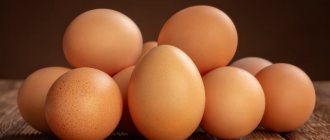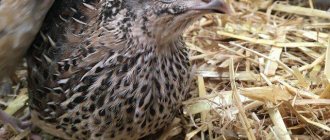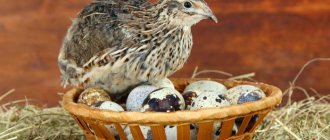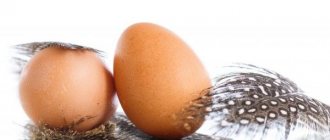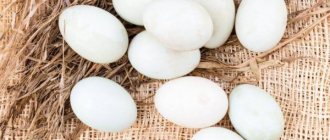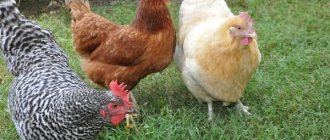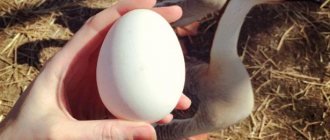What you need to know about the laying turkey
The process of egg production in turkeys depends on many factors, since the bird is quite demanding. Its duration can be affected by various factors, including the age of the bird, its well-being and living conditions. The most active birds for laying eggs are young birds aged 1 year. Further, two- and three-year-old birds reduce their activity and lay 30% fewer eggs than one-year-old birds. To improve egg production, the producer, as a rule, selects birds aged one and a half years with the best performance.
Things to remember
To encourage turkeys to lay eggs, many farmers artificially stimulate the flock by increasing lighting and creating a warm microclimate in the poultry house. Regular abuse of activation is dangerous for the health of the species, especially for young animals that have not reached the mature age of 7-8 months. The body develops incorrectly, so problems will begin to worry in the future.
Eggs are laid too early, there are many small specimens, and the quality of the offspring will be low.
For poultry breeders, its egg production is important. The concept of egg production includes the number of eggs produced and quality indicators. Therefore, the question of when turkeys begin to lay eggs and how to place the bird on the nest is one of the most important.
When turkeys start laying eggs: timing
Even where all the turkeys initially lay eggs, the presence of fluff indicates that one of them is preparing to hatch.
The normal age for a turkey to start laying eggs is considered to be 28-33 weeks or 7-9 months of a bird’s life. There are exceptions; sometimes a bird begins to lay eggs even at the age of six months. For the poultry farmer, not only the age at which eggs begin to be laid is important, but also their quality.
Turkeys begin laying eggs for their offspring in March-April. By this time, young turkeys are already ready for the process of reproduction.
Egg laying usually occurs in spring and autumn. During this period, a turkey hatches about 80 eggs, their number depends on the breed. The carrying period lasts 2.5 – 3 weeks. For the reproduction of offspring, spring clutches are preferable, since in the fall the turkey may not survive on the clutch.
After the bird stops laying eggs, 11 to 18 eggs are placed in the clutch. Their number depends on the size of the egg. Perhaps he will also add chicken or goose eggs to the clutch. The process of hatching chicks lasts about a month.
Usage
Turkey eggs are not sold in supermarkets along with chicken eggs. But this does not mean that they are inedible or have an unpleasant taste. In terms of nutritional value, they are second only to quail. Due to their alkaline composition, they are useful for inflammatory diseases of the gastrointestinal tract and high acidity. In the absence of individual intolerance, the product can be introduced into the daily diet by preparing omelettes, salads, baked goods and other dishes.
The reason for the lack of eggs on free sale is only the unprofitability of their production - the egg production of turkeys is lower than that of chickens, they reach sexual maturity later, and a lot of space is required to keep large birds. It is more profitable to use masonry to produce young animals.
From the moment the turkeys start laying eggs until the end of the breeding period, they hatch 40-60 poults. By the age of 5 months, the total live weight of young animals reaches 250-350 kg. Raising this bird is also considered profitable because 3-4 feed units are consumed per 1 kg of weight gain in young animals (1 unit is equivalent to 1414 kcal).
- Related Posts
- Broiler turkeys
- How many eggs does a turkey lay?
- How long do turkeys live?
- Turkeys Hybrid Converter
- How to pluck a turkey?
- Yellow diarrhea in turkeys
Number of eggs a turkey lays
Eggs for subsequent lining should be stored in a dark, cool place.
In spring, when there is up to 10 hours of daylight, the bird begins the process of oviposition. At this time, the number of eggs laid depends on the duration of daylight hours. The longer it lasts, the more eggs. Typically, a laying hen lays one egg per day. Then comes a break. This means that the bird is ready to hatch offspring.
The egg appears early in the morning. During the period of preparation for laying, the bird produces about 40 - 60 eggs.
Content
In order for birds to fly, experienced breeders think through the optimal living conditions. In addition to a complete diet, turkey has room and temperature requirements. Beginning farmers often make mistakes, so they cannot achieve the first result for several months.
In order for the female to lay the first egg, it is necessary to increase the duration of daylight hours. There is no need to illuminate the room around the clock; a minimum of ten to twelve hours a day is enough. This feature stimulates the “lady’s” body, forcing the production of reproductive hormones.
In order for the bird to start laying eggs, it is necessary to maintain optimal indoor conditions. A delicate and capricious turkey will not be productive in a damp, cold barn. Starting from the first months of life, the species requires maximum attention. The stable temperature should not fall below 5 degrees. Sudden jumps or frost causes females to stop laying.
Dirt in the house is another reason why the turkey has not started laying eggs. Lack of hygiene in the room negatively affects the general condition. The livestock will suffer from infections and parasites. Having been ill, it will not immediately restore reproductive abilities.
What to consider when hatching offspring
The demands of the turkey when reproducing offspring are known. As soon as the bird has stopped laying eggs, the nest should be cleaned and the hay bedding replaced. The eggs are removed from the nest from the container and placed in a cool place. Straw is laid on the bottom of the nest, then hay, and eggs are placed on the side.
Everything necessary for the bird: a feeder, a drinking bowl is located near the laying site. The turkey must be able to eat and drink in the immediate vicinity of the nest site, which she does once every 2 days. It is advisable to place sand nearby; the bird loves to swim in it. Typically, a turkey hatches its offspring for a month, and in the last days it almost does not leave its place for walks.
Incubation
To incubate chicks in birds of this species, the body temperature of the expectant mother increases to 42 degrees. How many eggs fit under one turkey? On average, from 12 to 15 pieces, but not everyone can ripen well and evenly. Those located on the edge will be colder than the central ones, so the female “mixes” the clutch almost 50 times during the day.
Remember that a one-year-old bird is not the best choice for a brood hen. To begin incubation, professionals prefer females between two and four years of age. Such individuals are less timid and impulsive, so they sit out the clutch until the end.
How to put a bird on a nest
A turkey nest must have one marked egg that remains there at all times.
In order for a turkey to sit on the nest without any problems, it needs special conditions:
- You should arrange a place to sit in a quiet and dark place;
- The ambient temperature should be above +10 degrees;
- You can fit a clean box under the nest; sand is sprinkled on the bottom and lined with straw and hay;
- A feeder is placed near the nest where there should be food (dairy products, vegetables, sprouted grains, pine flour), a drinking bowl is placed, and a place is provided for sand and ash.
Since turkeys are usually caring mothers and can sit on the nest for a long time without walks or food, the owner needs to take measures to ensure that the bird does not weaken. Sometimes it must be forcibly brought to food or taken outside.
A metal box is not at all suitable for a nest. During the hatching process, the turkey moves the eggs; they may end up next to the cold metal wall, which will lead to their cooling.
Sometimes a bird does not like the nest prepared for it, and it looks for a new one. In order for the bird to get used to the place, it is forced onto the nest and covered with a basket on top. After some time, the bird calms down and gets used to it.
Can a male hatch offspring?
There is a turkey sitting in the second nest. The eggs are about to hatch!
The turkey has all the qualities to hatch its offspring. It has a strong protective instinct and has a thick feather covering. Turkeys, when there are not enough females, or when there are too many eggs, are able to hatch a clutch.
In order to force the male to act as a hen, several eggs are placed in the nest, the turkey is seated and covered with a basket so that he cannot stand up to his full height. If after several days the turkey remains on the nest without a basket, then it is able to sit on the clutch. If the bird leaves the nest, then he is not suitable for the role of a hen.
Video about mother hen turkey
Males who sit on the nest have their own distinctive characteristics from females:
- Since they are larger and weigh more, eggs of other poultry are not placed in the nest, and stronger turkey eggs are chosen.
- They have a more aggressive character, so they do not like the actions of the bird in relation to it and the nest. To check a turkey's nest, hold the turkey tightly by grasping its wings, quickly adjust the nest, and then sit the bird down while it is confused. Next, you need to quickly leave the premises.
- Turkeys can also carefully look after hatched chicks while other males do not see them.
Feeding
In order for the turkey not to stop laying eggs, you need to properly organize your diet. Poultry with insufficient mobility is prone to obesity, and a deficiency of nutrients will immediately affect the quality of the product. The species requires more vitamins and proteins than chickens.
Turkeys need to be fed correctly
Turkeys are fed three times a day. In the morning and afternoon they give wet mash with the addition of chopped grass, and at night they prefer to eat whole grains. Special feed is used both as a supplement and as a separate dish.
To ensure that birds lay eggs well, the menu includes sprouted grains, yeast and mineral supplements with B vitamins. It is very useful to dilute the diet with root vegetables and grass meal. To improve egg composition, farmers recommend open grazing in summer.
If the bird lays eggs every day, then you need to include 3 to 10 grams of cottage cheese in the menu. Chalk, table salt and bone meal must be present all year round. A lack of microelements will immediately affect the quality and quantity of products.
By the way, boiled root vegetables have a positive effect on poultry health. Potatoes make the egg bigger, so farmers add up to 120 grams per day. It is better not to abuse meat and fish waste.
What to do if your turkey doesn't lay eggs
Sometimes the poultry farmer does not know the start time of egg laying and misses this time. The bird is putting on excess fat and may not start laying eggs at all, or it is sick, or it is not being properly cared for. In order for a bird to start laying eggs, it is sometimes necessary to do simple things:
- Improve nutrition;
- Protect her from stress;
- Make additional lighting;
- Provide a temperature of +10 degrees and above.
There are some minor nuances in the question of when turkeys start laying eggs. People say that all poultry begins to fall apart after the Nativity of Christ, that is, after January 7th. The countdown begins from here: the first egg will appear in approximately 3 weeks, at the beginning of February. After a month, you need to monitor when the turkey begins to “sit” - cover the nest with down and additional straws, etc.
Professional care, taking into account all the subtleties of maintenance, will provide the owner with the necessary egg production of the turkey.
Video about how to force turkeys to leave their nest periodically
Beginning of egg production
Egg production is associated with the physiological characteristics of birds and the puberty of turkeys. Individuals of different breeds mature differently. Turkey keepers need to know at what age turkeys start laying eggs.
Experts say that in heavy breed turkeys, puberty occurs at 8-9 months. Females can lay their first clutch at the age of 9-10 months. Light weight birds and birds with egg production develop faster. Their period of growing up is 7-8 months. They begin to lay eggs at 8-9 months of age:
- During puberty, the pituitary gland begins to actively function. It releases hormones that promote the development of reproductive organs in birds. The left ovary increases in size and eggs mature in it. They are enclosed in a dense follicle shell. When the cell matures, the membrane bursts and the cell passes through the oviduct. The egg is the yolk, which contains nutrients. The right ovary of the turkey is atrophied;
- the functions of the oviduct develop. The cells of the mucous membrane begin to produce secretions. The muscles move the yolk along the oviduct: the cell moves in a downward spiral. As it passes through the tube, it collects a secretion that forms protein. It has a liquid or viscous consistency;
- a dense protein wraps the cell in the isthmus of the oviduct. This is where the shell of the egg is formed. It is thin and elastic;
- From the isthmus the cell enters the uterus. Crystallization of the elastic shell occurs in it: a shell is formed. The crystals are represented by salts of calcium, sodium, phosphorus and other minerals;
- the formed egg leaves the uterus through the vagina, which has access to the cloaca;
- the release of the cell gives a signal for the release of the next egg from the follicle. The egg formation cycle repeats;
- To form a full-fledged turkey egg with a normal shell, the female needs 26 hours.
The first masonry does not perform well. The eggs are small, the yolk is depleted of nutrients. They are not used for incubation, but they can be eaten. After a week, the turkey begins to produce full eggs. Select medium-sized samples with smooth and clean shells.
The turkey should be prepared for egg production. She is prescribed a special diet that promotes the normal development of the reproductive organs. The female receives 350 g of food. It is recommended to study the following diet (for 10 heads):
- the basis is boiled potatoes; it is given 1.5 kg;
- corn, barley and cereal crops are introduced - 900 g;
- cottage cheese – 30 g;
- 300 g each of wheat and barley bran;
- 400 g – vegetables that are rich in carotene: carrots, beets, pumpkin;
- minced meat or fish – 10 g;
- chalk – 30 g;
- bone meal – 25 g;
- table salt 15 g;
- Once every 2 weeks it is recommended to feed the livestock with a solution of potassium permanganate.
The turkey should not lay its first clutch earlier or later than expected. If laid early, productivity will be low and the eggs will be small. If the turkey begins to lay eggs late, the eggs will be large, but their number will not correspond to the norm.
It is recommended to study the physiological characteristics of the breed in order to achieve a timely onset of puberty in birds. The following breeds of turkeys are most in demand among farmsteaders:
| № | Helpful information |
| 1 | bronze North Caucasian turkeys - puberty is noted at 9-10 months |
| 2 | Moscow bronze – 8.5-9 months |
| 3 | white North Caucasian turkey begins to lay eggs at 8-9 months |
| 4 | females of the white broad-chested breed carry out their first clutch at 9.5-10 months |
Until the specified period, laying hens are kept in daylight for no more than 10 hours. Fermented milk products are not added to the mash. Potatoes, peas, and corn are removed from the diet. These products stimulate sexual development in birds.
When keeping turkeys at home, certain sanitary standards are maintained. The birds are placed on clean bedding; the room is kept at an air temperature of 22 C and a humidity of 60%. It is necessary to regularly ventilate the room. Keep the feeders and drinkers clean.
If the first clutch occurs at the beginning of March, then the productivity of laying hens continues on average until August. The number of eggs depends not only on the characteristics of the breed, the conditions of keeping the bird, but also on the month of productivity. Experts provide average data:
- month - a turkey can lay 12 eggs;
- 16 pcs.;
- 16 pcs.;
- 14 pcs.;
- 12 pcs.;
- 10 pieces.
The female does not lay eggs every day. In the first days of productivity development, an egg is formed in 2-3 days. In the future, the female can lay eggs every day. On average, a turkey lays eggs once every 2 days. The most productive months are 2-3 months of the cycle. In August, birds begin to molt.
The feather change continues until October-November. In winter, turkeys kept at home do not lay eggs. At large poultry farms, conditions are created to increase the cyclicity of individuals. Females can lay eggs in winter. Average productivity in females of various breeds:
- bronze North Caucasian turkeys – 80 pcs. per season;
- Moscow bronze – 100 pcs.;
- white North Caucasian – 100 pcs.;
- white broad-breasted – 85 pcs.
Farmers discuss on forums what cycle of productivity can be considered the norm, how to determine it if females lay eggs 2-3 times a week. Experts say that turkeys exhibit not only seasonal, but also intraseasonal cyclicity.
Poultry farming is an accessible and inexpensive option for obtaining fresh produce at home. Lack of information among inexperienced farmers can worsen the performance of even the most undemanding breed. When do turkeys start laying eggs? Let's look at the important physiological aspects of the species.
Suitable age for turkeys to lay eggs
